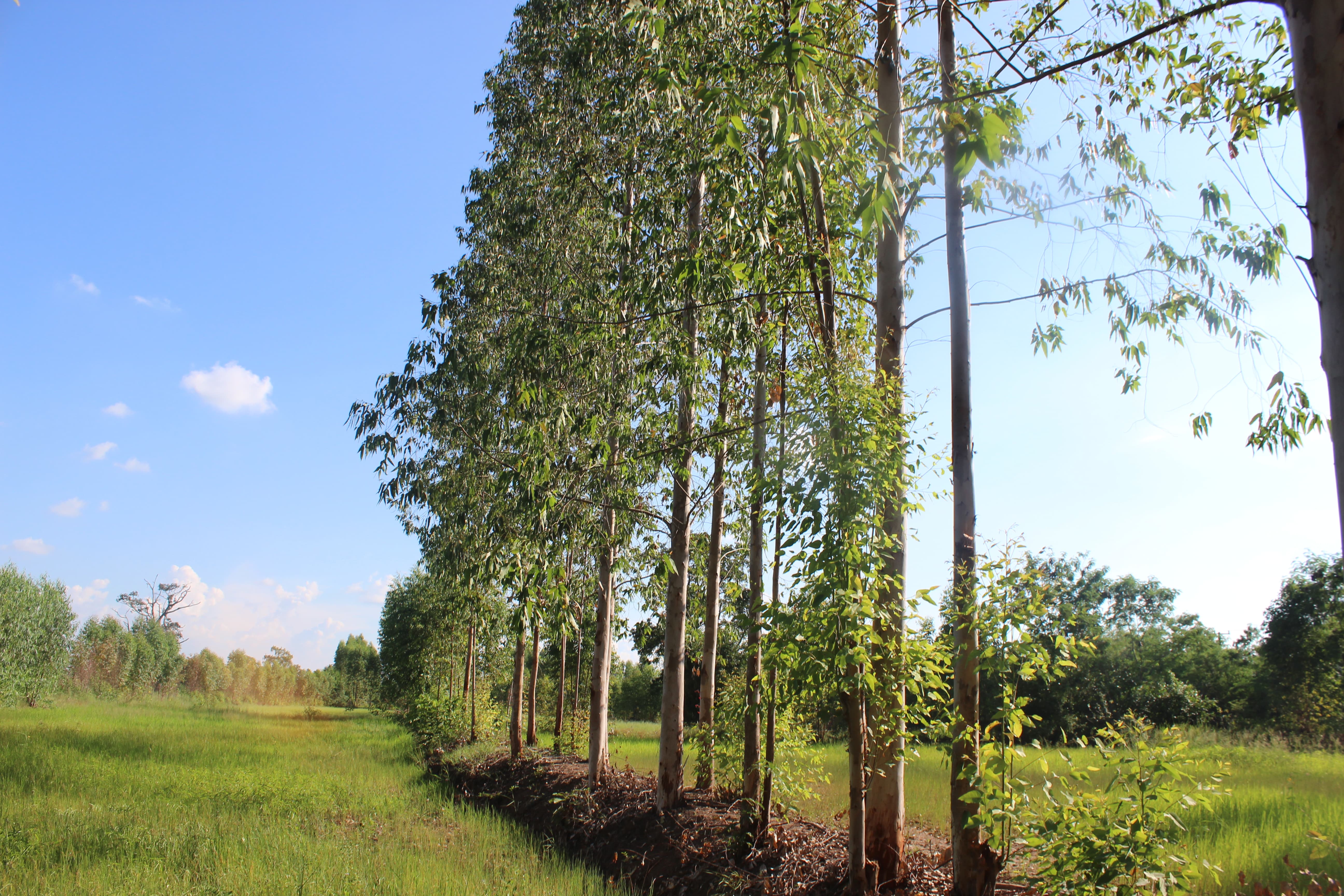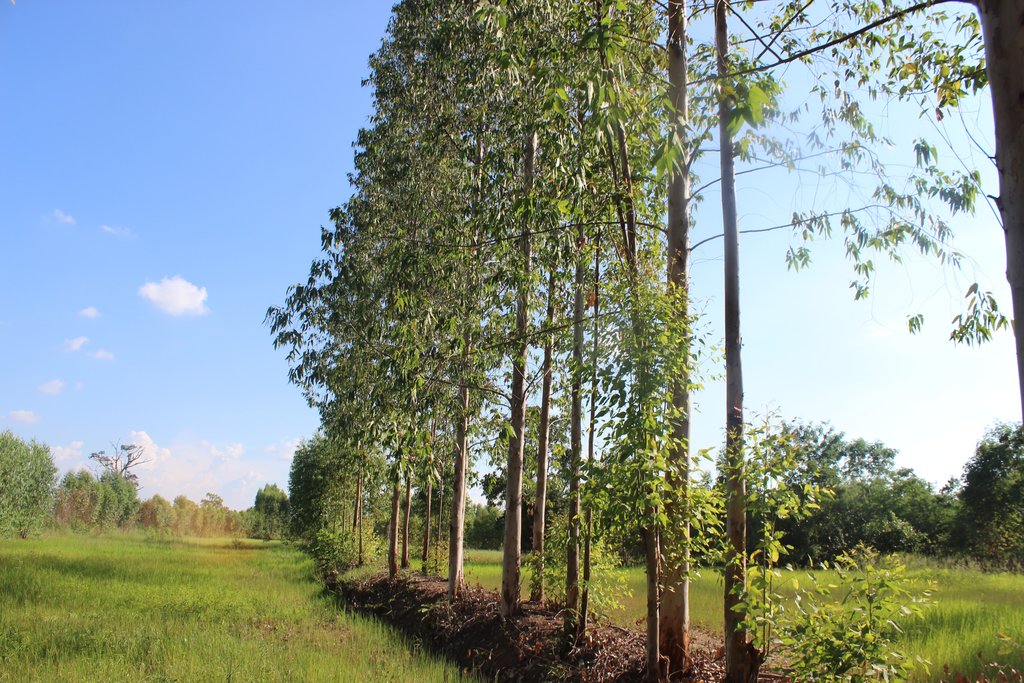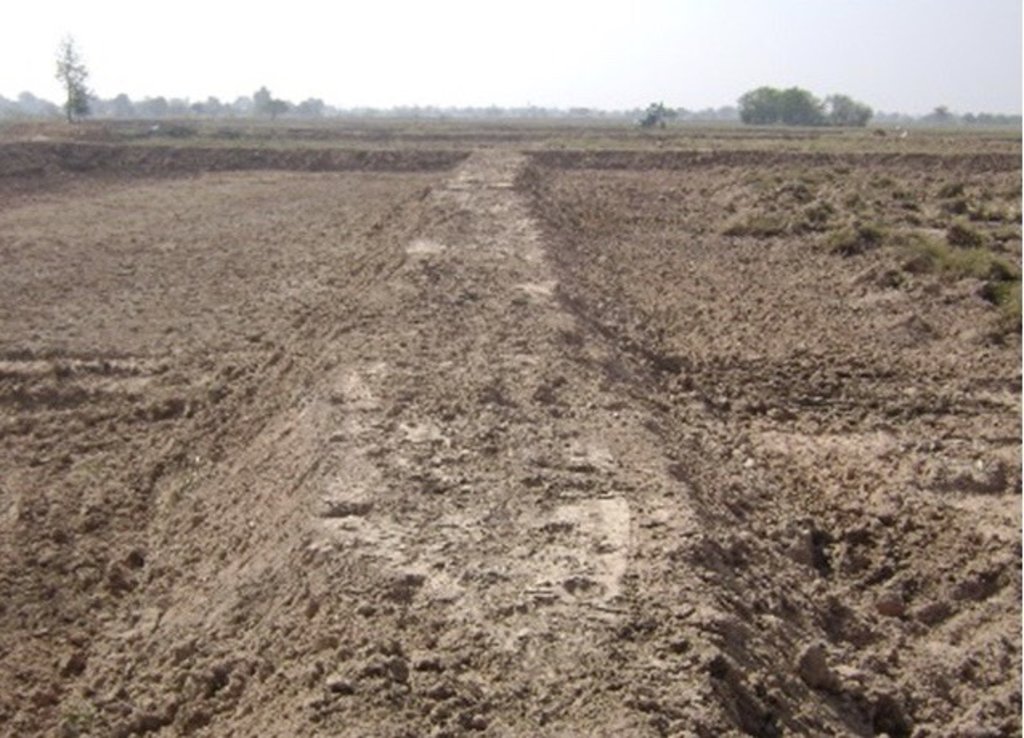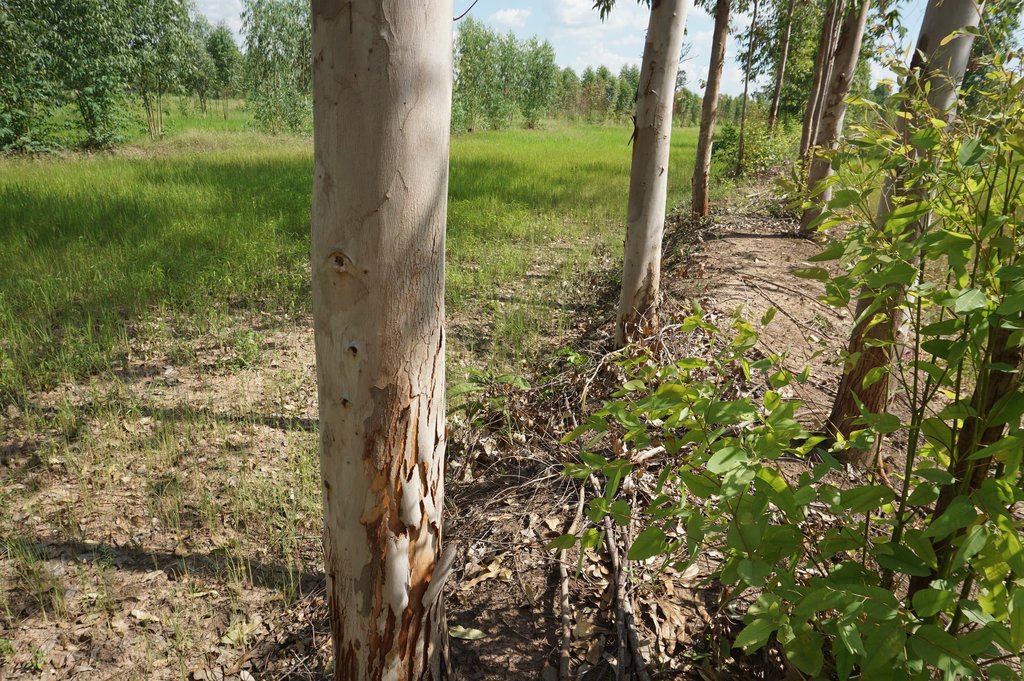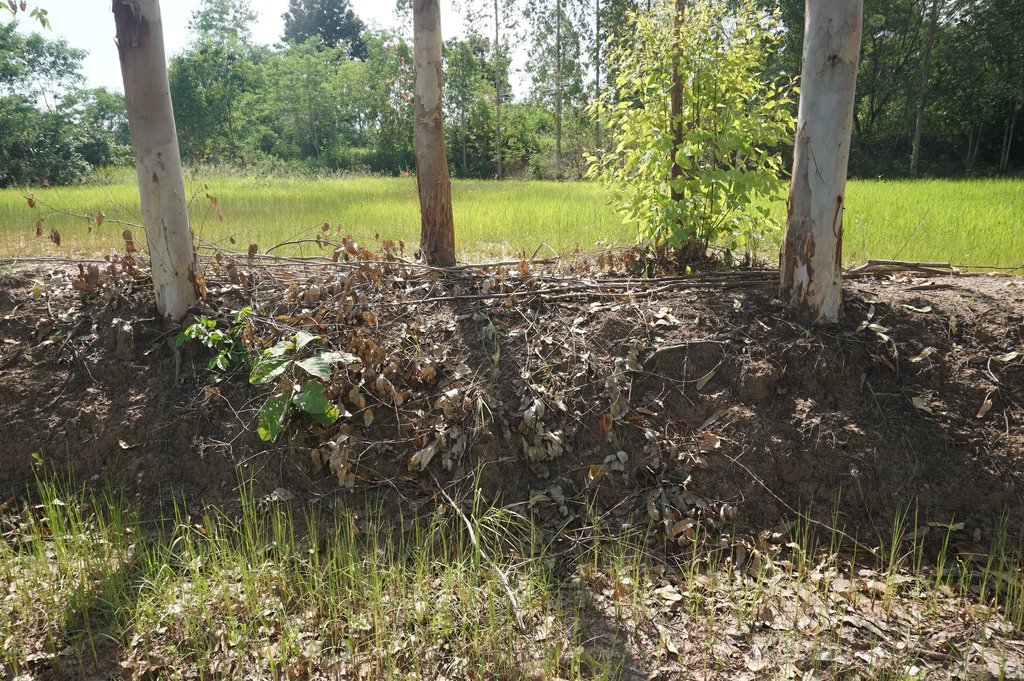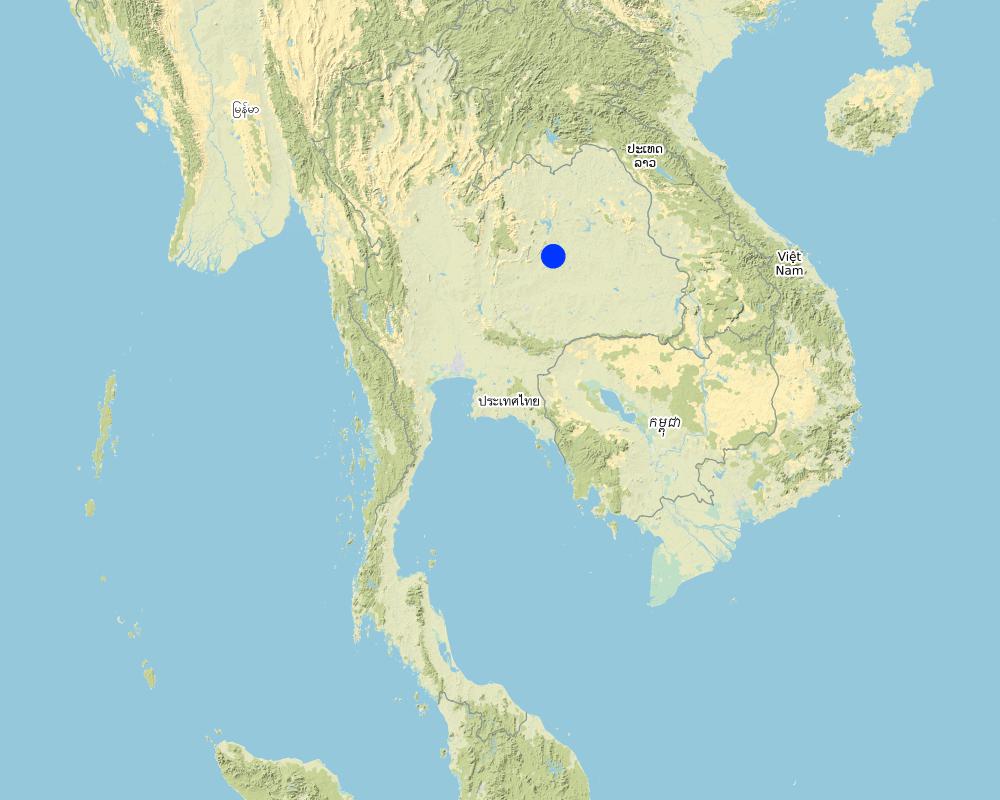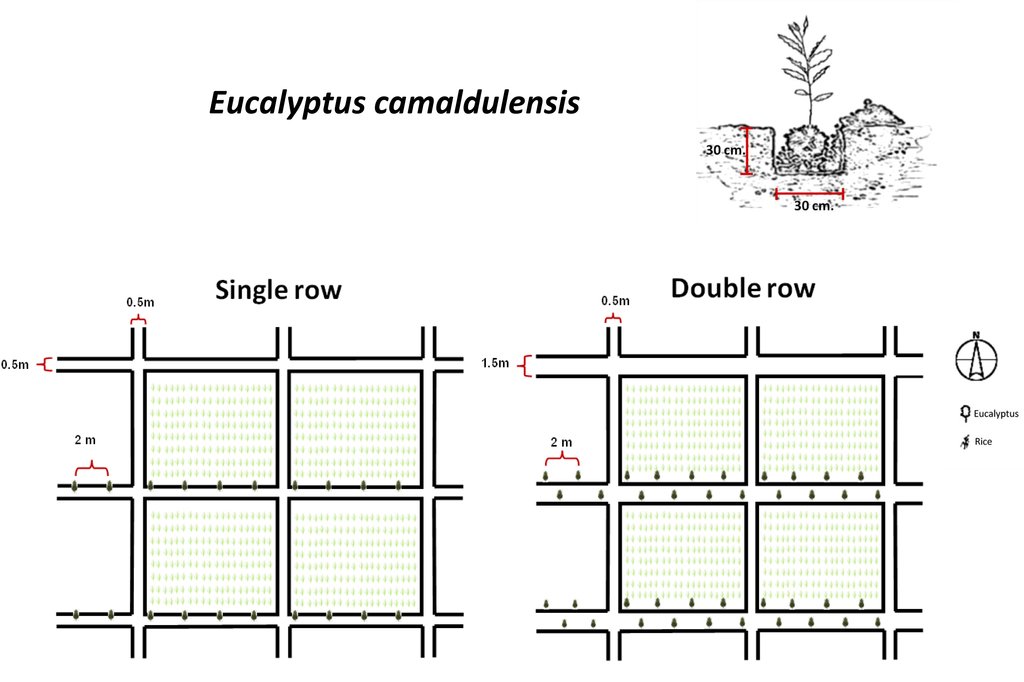Planting Eucalyptus on rice bunds to lower saline groundwater [Tailandia]
- Creación:
- Actualización:
- Compilador: Areerat Wangkaew
- Editor: –
- Revisores: Rima Mekdaschi Studer, Samran Sombatpanit, Pitayakon Limtong, William Critchley
Planting perennial salt-tolerant trees in salt-affected areas of the Northeast of Thailand.
technologies_4099 - Tailandia
Visualizar secciones
Expandir todo Colapsar todos1. Información general
1.2 Detalles de contacto de las personas de referencia e instituciones involucradas en la evaluación y la documentación de la Tecnología
Persona(s) de referencia clave
usuario de la tierra:
Chuenchai Sayan
+66-99-0254108
Ban Muang Pia, Muang Pia Sub-district, Ban Phai District, Khon Kaen 40110
Tailandia
Especialista MST:
Sritumboon Supranee
ssritumboon@yahoo.com
Land Development Department
2003, 61 Phaholyothin Road, Ladyao, Chatuchak, Bangkok 10900
Tailandia
Especialista MST:
Pothinam Pornpana
laosuwan18@hotmail.com
Land Development Department
2003, 61 Phaholyothin Road, Ladyao, Chatuchak, Bangkok 10900
Tailandia
Especialista MST:
Rophandung Weera
weerop@hotmail.com
Land Development Department
2003, 61 Phaholyothin Road, Ladyao, Chatuchak, Bangkok 10900
Tailandia
Especialista MST:
Srihaban Pranee
pranee.782@gmail.com
Land Development Department
2003, 61 Phaholyothin Road, Ladyao, Chatuchak, Bangkok 10900
Tailandia
Especialista MST:
Jakkarach Usa
usa.kl@hotmail.com
Land Development Department
2003, 61 Phaholyothin Road, Ladyao, Chatuchak, Bangkok 10900
Tailandia
Especialista MST:
Janplang Chettaruj
joeshua9@hotmail.com
Land Development Department
2003, 61 Phaholyothin Road, Ladyao, Chatuchak, Bangkok 10900
Tailandia
National consultant:
Arunin Somsri
ssarunin@gmail.com
Land Development Department
2003, 61 Phaholyothin Road, Ladyao, Chatuchak, Bangkok 10900
Tailandia
Nombre del proyecto que financió la documentación/ evaluación de la Tecnología (si fuera relevante)
Decision Support for Mainstreaming and Scaling out Sustainable Land Management (GEF-FAO / DS-SLM)Nombre de la(s) institución(es) que facilitaron la documentación/ evaluación de la Tecnología (si fuera relevante)
Land Development Department LDD (Land Development Department LDD) - Tailandia1.3 Condiciones referidas al uso de datos documentados mediante WOCAT
¿Cuándo se compilaron los datos (en el campo)?
01/10/2018
El compilador y la/s persona(s) de referencia claves aceptan las condiciones acerca del uso de los datos documentados mediante WOCAT:
Sí
1.4 Declaración de la sostenibilidad de la Tecnología descrita
¿La Tecnología aquí descrita resulta problemática en relación a la degradación de la tierra, de tal forma que no puede considerársela una tecnología sostenible para el manejo de la tierra?
No
Comentarios:
The technology is environmentally suited and very well accepted by the land users.
1.5 Referencia al (los) Cuestionario(s) de Enfoques MST
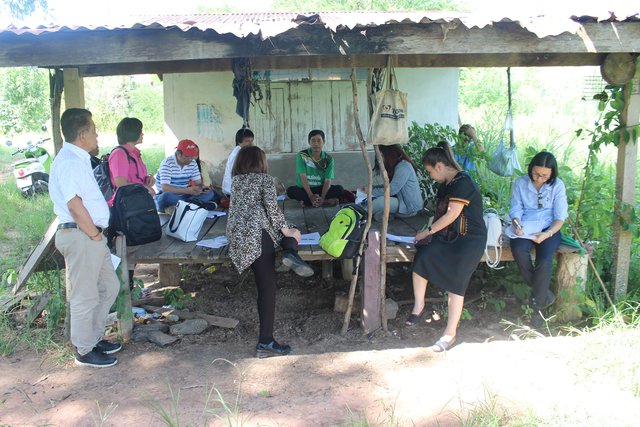
Advisory system for planting Eucalyptus camaldulensis on rice … [Tailandia]
The Thai government promotes planting of Eucalyptus camaldulensis on rice bunds to lower the saline groundwater level and prevent the spread of salt in soils - through cooperation of farmers, land owners, Siam Forestry Co., Ltd., Subdistrict Administration Organization, Land Development Department, and with specialists/ technical advisors.
- Compilador: Areerat Wangkaew
2. Descripción de la Tecnología MST
2.1 Breve descripción de la Tecnología
Definición de la Tecnología:
Eucalyptus camaldulensis variety H4 is salt tolerant and has the ability to lower shallow saline groundwater levels; as a result salinity is controlled. Planting eucalyptus on one or two sides of the rice bund in an east-west direction (in single or double rows) at a spacing of 2 m between trees is the most effective technique and well accepted by farmers.
2.2 Descripción detallada de la Tecnología
Descripción:
Eucalyptus camaldulensis cultivation on rice bunds to lower shallow saline groundwater levels in low-lying areas is a technology used on salt-affected land. The LDD Perennial Tree Planting project to promote the technology of planting Eucalyptus camaldulensis on rice bunds has been implemented since 1996. The land user interviewed cultivates a moderately salt-affected rice field at Ban Muang Pia District, Khon Kaen Province. The land is used for rice production both glutinous (variety RD 6) and non-glutinous fragrant rice (Hom Mali 105). The average yield of rice is 200-250 kg/rai (1 ha = 6.25 rai). The farmers have planted eucalyptus on bunds in the rice cultivated areas on about 10,000 rai in more than 10 years with the objectives of remedying and preventing salination by lowering shallow saline groundwater levels, through "bio-drainage" as well as increasing income and better utilization of lands on rice bunds for growing trees.
The technology of eucalyptus cultivation on rice bunds has been implemented in farmers' fields in the low-lying salt-affected rice area common in the Northeast of Thailand. It is widely accepted by farmers through the joint partnership between the Land Development Department (LDD), Siam Forestry Co., Ltd. and the local district administration. Eucalyptus seedlings are provided by LDD and are planted in a single or double rows - double rows with trees planted on two sides of the rice bunds in a zigzag manner following an east-west direction to prohibit a shadow effect. The spacing between the trees in a row is 2 m: the rice bund was adapted to be 1.5 m wide and 0.5 m high. This provides more space and convenient access to the rice field. The project provides labour costs for farmers to prepare the land before planting. Many farmers outside the project transplanted their own eucalyptus seedlings on the bunds of 0.5 m or more in width. Farmers buy the seedlings at 1 THB each and plant in pits of 0.3 x 0.3 x 0.3 m with 0.5 kg compost and 0.5 kg rice husks from farm by-products. This technology is well accepted by farmers because of the effective control of salinity in the rice fields as well as the higher income obtained from selling eucalyptus wood. Farmers observed the dead patchy spots of rice plants with salt crusts before planting eucalyptus: after 2 cutting cycles no salt patches were observed anymore, and rice yields increased noticeably. There was also extra income from selling poles of eucalyptus every 4 years. The average yield of eucalyptus trees of 2.5-3.0 inches in diameter was 16 tons per rai for the first cutting.
Based on 7 years (2 crops of eucalyptus coppicing), the average additional income was 1,087 THB/rai/yr (according to the farmers' and Siam Forest's information). The main investment was in the first year of planting; later on, the maintenance cost was on labour for weeding, pruning and thinning to 3 stems after coppice/cutting, including adding 15-15-15 fertilizer for each tree. The average income is increased through better rice yields. The benefits of the technology according to interviews are creating a cooler microclimate from eucalyptus trees and changes in biodiversity through better soil quality resulting in more species of flora and fauna such as grasses, wildflowers, dragonflies, earthworms in the rice field and on the bund. Some farmers wanted more trees by planting at closer spacing of 1 m, but this resulted in too great a density of trees thus consuming more surface water and competing with rice for water consumptive use.
2.3 Fotografías de la Tecnología
2.4 Videos de la Tecnología
Comentarios, descripción breve:
The video shows the area of eucalyptus growing on the rice bund.
Fecha:
01/10/2018
Lugar:
Ban Muang Pia, Khon Kaen
Nombre del videógrafo:
Supranee Sritumboon
Comentarios, descripción breve:
Farmer interview and SLM discussion.
Fecha:
01/10/2018
Lugar:
Ban Muang Pia, Khon Kaen
Nombre del videógrafo:
Supranee Sritumboon
2.5 País/ región/ lugares donde la Tecnología fue aplicada y que se hallan comprendidos por esta evaluación
País:
Tailandia
Región/ Estado/ Provincia:
Khon Kaen
Especifique más el lugar :
Ban Phai
Comentarios:
The SLM Technology site for planting eucalyptus in a rice production area.
Map
×2.6 Fecha de la implementación
Indique año de implementación:
1996
2.7 Introducción de la Tecnología
Especifique cómo se introdujo la Tecnología:
- mediante proyectos/ intervenciones externas
- by other land users
Comentarios (tipo de proyecto, etc.):
The project initiated by the government (Land Development Department) collaborated with private enterprises (Siam Forestry Co., Ltd.), local administration, communities and land users.
3. Clasificación de la Tecnología MST
3.1 Propósito(s) principal(es) de la Tecnología MST
- mejorar la producción
- reducir, prevenir, restaurar la degradación del suelo
- preservar/ mejorar biodiversidad
- crear impacto económico benéfico
3.2 Tipo(s) actuales de uso de la tierra donde se aplica la Tecnología

Tierras cultivadas
- Cosecha anual
- Cultivos perennes (no leñosos)
Cosechas principales (comerciales y de subsistencia):
Rice
Comentarios:
Planting eucalyptus for additional income and more intensive utilization of land on the rice bunds.
Si el uso de la tierra ha cambiado debido a la implementación de la Tecnología, indique el uso de la tierra antes de la implementación de la Tecnología.
Before planting eucalyptus, rice was the only crop. Due to the shallow saline groundwater of the area, rice had shown symptoms of being salt-affected; however after planting eucalyptus trees, these symptoms disappeared.
3.3 Información adicional sobre el uso de tierras
Provisión de agua para la tierra donde se aplica la Tecnología:
- de secano
Comentarios:
Average annual rainfall is 1,200-1,300 mm.
Número de temporadas de cultivo por año:
- 1
Especifique:
Land use is for rice production; the technology is planting Eucalyptus camaldulensis on rice bunds.
Densidad del ganado (si fuese relevante):
Only few cattle, swine, and boar are in the land user's farm.
3.4 Grupo MST al que pertenece la Tecnología
- agroforestería
- manejo de agua subterránea
- desalination
3.5 Difusión de la Tecnología
Especifique la difusión de la Tecnología:
- distribuida parejamente sobre un área
Si la tecnología se halla difundida homogéneamente en un área, indique el área aproximada que cubre:
- 1-10 km2
Comentarios:
The technology has spread over the area of 10,000 rai (1 ha = 6.25 rai) owned by farmers/land users both under and outside the supported project of planting eucalyptus on rice bunds.
3.6 Medidas MST que componen la Tecnología

medidas agronómicas
- A2: materia orgánica/ fertilidad del suelo
- A5: Manejo de semillas, variedades mejoradas

otras medidas
Comentarios:
Eucalyptus camaldulensis H4 is the salt-tolerant variety used for lowering shallow saline groundwater.
3.7 Principales tipos de degradación del suelo encarados con la Tecnología

deterioro químico del suelo
- Cn: reducción de la fertilidad y contenido reducido de la materia orgánica del suelo (no ocasionados por la erosión)
- Cs: salinización/ alcalinización

deterioro físico del suelo
- Pc: compactación
- Pk: desmoronamiento y encostramiento

degradación biológica
- Bc: reducción de la cobertura vegetal del suelo
- Bq: reducción de la cantidad/ biomasa
- Bs: reducción en la calidad y composición/ diversidad de las especies
- Bl: pérdida de la vida del suelo

degradación del agua
- Hg: cambio en nivel de aguas subterráneas/ nivel de acuífero
- Hq: reducción de la calidad de aguas subterráneas
3.8 Prevención, reducción o restauración de la degradación del suelo
Especifique la meta de la Tecnología con relación a la degradación de la tierra:
- reducir la degradación del suelo
- restaurar/ rehabilitar tierra severamente degradada
Comentarios:
Decreased saline groundwater levels to control salinity distribution in rice cultivated areas.
4. Especificaciones técnicas, actividades de implementación, insumos y costos
4.1 Dibujo técnico de la Tecnología
4.2 Especificaciones técnicas/ explicaciones del dibujo técnico
1. Seedling of Eucalyptus camaldulensis H4, a salt-tolerant variety, were planted. The age of seedlings was 3-month old. The rice bund was regulated to 0.5 m wide for planting eucalyptus in single row or 1.5 m wide for planting in double rows (in a zigzag manner), 0.5 m high with a spacing of 2 m between the trees along an east-west direction. The number of trees was 80/rai or 500/ha for double rows planting.
2. Planting technique: 0.5 kg of compost mixed with 0.5 kg of rice husks was applied at the bottom of a pit of 0.3 x 0.3 x 0.3 m before seedlings were planted.
4.3 Información general sobre el cálculo de insumos y costos
Especifique cómo se calcularon los costos e insumos:
- por área de Tecnología
Indique tamaño y unidad de área:
own by one selected land user
Si utiliza una unidad de área local, indique el factor de conversión a una hectárea :
1 hectare = 6.25 rai
otra / moneda nacional (especifique):
THB
Indique la tasa de cambio de USD a la moneda local (si fuese relevante): 1 USD =:
32,0
Indique el costo promedio del salario de trabajo contratado por día:
300 THB
4.4 Actividades de establecimiento
| Actividad | Tipo de medida | Momento | |
|---|---|---|---|
| 1. | Site selection of salt-affected area | Estructurales | May-July |
| 2. | Land preparation; bunds construction and seedling preparation | Estructurales | May-July |
| 3. | Public hearing, joint meeting between farmers and researchers | Otras medidas | May-July |
| 4. | Demonstration plot | Agronómicas | May-July |
| 5. | Model establishment (Eucalyptus planting method) | Agronómicas | May-July |
| 6. | Joint monitoring, evaluation and follow up for planting | Otras medidas | After planting |
Comentarios:
No irrigation water therefore the planting time depends on the period of early rainy season which will be from May to July.
4.5 Costos e insumos necesarios para el establecimiento
| Especifique insumo | Unidad | Cantidad | Costos por unidad | Costos totales por insumo | % de los costos cubiertos por los usuarios de las tierras | |
|---|---|---|---|---|---|---|
| Mano de obra | Labour cost for planting eucalyptus (labour wage per day = 300 THB, 1 rai required a labour cost of 600 THB) | Rai | 1,0 | 600,0 | 600,0 | |
| Material para plantas | Eucalyptus seedling cost (80 trees/rai), 1 THB for each seedling | Seedling | 80,0 | 1,0 | 80,0 | |
| Fertilizantes y biocidas | Compost cost 3.5 THB/kg, 0.5 kg/pit | kg | 40,0 | 3,5 | 140,0 | |
| Fertilizantes y biocidas | Rice husk cost 4 THB/kg, 0.5 kg/pit | kg | 40,0 | 4,0 | 160,0 | |
| Costos totales para establecer la Tecnología | 980,0 | |||||
Si el usuario de la tierra no cubrió el 100% de los costos, indique quién financió el resto del costo:
Land Development Department
Comentarios:
Labour cost for land preparation and planting borne by LDD and seedlings borne by Siam Forestry Co., Ltd.; compost and rice husk were from farm by-products.
4.6 Actividades de establecimiento/ recurrentes
| Actividad | Tipo de medida | Momento/ frequencia | |
|---|---|---|---|
| 1. | Thinning and pruning after first year of planting | Agronómicas | 2 times/rain season |
| 2. | Weeding after first year of planting | Agronómicas | 2 times/rain season |
| 3. | Fertilizer application after first year of planting | Agronómicas | 2 times/rain season |
| 4. | Cutting and selling logs | Agronómicas | 4th and 7th year |
Comentarios:
Four years after planting, the poles will be cut and sold. After cutting, the tree coppices, then thinning is needed in order to leave not more than 3 stems, necessary for better growth of the tree trunks. Weeding is important during rainy season to control competition for fertilizer.
4.7 Costos e insumos necesarios para actividades de mantenimiento/ recurrentes (por año)
| Especifique insumo | Unidad | Cantidad | Costos por unidad | Costos totales por insumo | % de los costos cubiertos por los usuarios de las tierras | |
|---|---|---|---|---|---|---|
| Mano de obra | Labour cost of weeding, pruning, thinning, and fertilizer application for 150 THB/time, 2 times/rai/yr, based on the labour wage of 300 THB/day | Time | 2,0 | 150,0 | 300,0 | |
| Fertilizantes y biocidas | Cost of 15-15-15 chemical fertilizer (13 THB/kg, application rate 50 g/tree; 50 g x 80 trees per rai = 4 kg/rai | kg | 4,0 | 13,0 | 52,0 | |
| Indique los costos totales para mantenecer la Tecnología | 352,0 | |||||
Comentarios:
Land users do the job by themselves without hiring labourers. Furthermore, the fertilizer application will be the same fertilizer and timing as is used for rice. No extra fertilizer needed for trees because the trees will consume fertilizer from the rice field.
4.8 Factores más determinantes que afectan los costos:
Describa los factores más determinantes que afectan los costos:
Maintenance cost of weeding, pruning, thinning and fertilizer application was 428 THB/rai/yr. Calculation is based on 7 years of planting. Four years after planting, the logs were sold for additional income 5,714.3 THB/rai. On the 7th year, the logs were sold at 4,285.7 THB/rai.
(Income from 2 times of Eucalyptus sale; 4th year = 40,000 THB, 7th year = 30,000 THB. Therefore, total income for 7 years = 10,000 THB/rai. Benefit from Eucalyptus planting = 10,000–2,388 (planting cost + 4 years of maintenance cost) = 7,612 THB/7 years = 1,087 THB/rai/yr.)
Compost and rice husk are from farm by-products and the labour costs are from land users. The income thereore will be higher than 1,087 THB/rai as estimated.
5. Entorno natural y humano
5.1 Clima
Lluvia anual
- < 250 mm
- 251-500 mm
- 501-750 mm
- 751-1,000 mm
- 1,001-1,500 mm
- 1,501-2,000 mm
- 2,001-3,000 mm
- 3,001-4,000 mm
- > 4,000 mm
Especifique el promedio anual de lluvia (si lo conoce), en mm:
1200,00
Especificaciones/ comentarios sobre la cantidad de lluvia:
Average annual rainfall from 2003-2012
Indique el nombre de la estación metereológica de referencia considerada:
Meteorological Department
Zona agroclimática
- semi-árida
Average temperature 21-36 degree Celsius, relative humidity is 75%
5.2 Topografía
Pendientes en promedio:
- plana (0-2 %)
- ligera (3-5%)
- moderada (6-10%)
- ondulada (11-15%)
- accidentada (16-30%)
- empinada (31-60%)
- muy empinada (>60%)
Formaciones telúricas:
- meseta/ planicies
- cordilleras
- laderas montañosas
- laderas de cerro
- pies de monte
- fondo del valle
Zona altitudinal:
- 0-100 m s.n.m.
- 101-500 m s.n.m.
- 501-1,000 m s.n.m
- 1,001-1,500 m s.n.m
- 1,501-2,000 m s.n.m
- 2,001-2,500 m s.n.m
- 2,501-3,000 m s.n.m
- 3,001-4,000 m s.n.m
- > 4,000 m s.n.m
Indique si la Tecnología se aplica específicamente en:
- no relevante
Comentarios y especificaciones adicionales sobre topografía :
The geography is in the lower basin of Korat Plateau in the Northeast of Thailand.
5.3 Suelos
Profundidad promedio del suelo:
- muy superficial (0-20 cm)
- superficial (21-50 cm)
- moderadamente profunda (51-80 cm)
- profunda (81-120 cm)
- muy profunda (>120 cm)
Textura del suelo (capa arable):
- áspera/ ligera (arenosa)
Textura del suelo (> 20 cm debajo de la superficie):
- mediana (limosa)
Materia orgánica de capa arable:
- baja (<1%)
Si se halla disponible, adjunte una descripción completa de los suelos o especifique la información disponible, por ej., tipo de suelo, pH/ acidez de suelo, capacidad de intercambio catiónico, nitrógeno, salinidad, etc. :
Texture of top soil is sandy loam and more than 20 cm below the surface is sandy clay loam; pH = 7 and increasing with depth up to 8.5; soil salinity is moderately to highly affected which is identified by the salt crusts on the soil surface; very low P and K.
5.4 Disponibilidad y calidad de agua
Agua subterránea:
< 5 m
Disponibilidad de aguas superficiales:
pobre/ ninguna
Calidad de agua (sin tratar):
agua potable de mala calidad (requiere tratamiento)
¿La salinidad del agua es un problema?
Sí
Especifique:
Slightly saline
¿Se está llevando a cabo la inundación del área? :
No
Comentarios y especificaciones adicionales sobre calidad y cantidad de agua:
Shallow saline groundwater exists because of the low-lying discharge area and the source of the salt is under the surface of the land.
5.5 Biodiversidad
Diversidad de especies:
- baja
Diversidad de hábitats:
- baja
Comentarios y especificaciones adicionales sobre biodiversidad:
Before planting eucalyptus, species and habitat were low. After 7 years, dragonfly, earthworms, birds, rats, and wildflowers that were not seen before now are found.
5.6 Las características de los usuarios de la tierra que aplican la Tecnología
Sedentario o nómada:
- Sedentario
Orientación del mercado del sistema de producción:
- mixta (subsistencia/ comercial)
Ingresos no agrarios:
- 10-50% de todo el ingreso
Nivel relativo de riqueza:
- promedio
Individuos o grupos:
- individual/ doméstico
Nivel de mecanización:
- trabajo manual
Género:
- hombres
Edad de los usuarios de la tierra:
- ancianos
Indique otras características relevantes de los usuarios de las tierras:
Diligent farmer seeking more income by raising few cattle, swine, and boar.
5.7 Área promedio de la tierra que pertenece a o es arrendada por usuarios de tierra que aplican la Tecnología
- < 0.5 ha
- 0.5-1 ha
- 1-2 ha
- 2-5 ha
- 5-15 ha
- 15-50 ha
- 50-100 ha
- 100-500 ha
- 500-1,000 ha
- 1,000-10,000 ha
- > 10,000 ha
¿Esto se considera de pequeña, mediana o gran escala (refiriéndose al contexto local)?
- pequeña escala
Comentarios:
Farmers/ land owners outside the project have been planting eucalyptus on rice bunds and get additional income.
5.8 Tenencia de tierra, uso de tierra y derechos de uso de agua
Tenencia de tierra:
- individual, con título
Derechos de uso de tierra:
- individual
- rainfed
5.9 Acceso a servicios e infraestructura
salud:
- pobre
- moderado
- bueno
educación:
- pobre
- moderado
- bueno
asistencia técnica:
- pobre
- moderado
- bueno
empleo (ej. fuera de la granja):
- pobre
- moderado
- bueno
mercados:
- pobre
- moderado
- bueno
energía:
- pobre
- moderado
- bueno
caminos y transporte:
- pobre
- moderado
- bueno
agua potable y saneamiento:
- pobre
- moderado
- bueno
servicios financieros:
- pobre
- moderado
- bueno
6. Impactos y comentarios para concluir
6.1 Impactos in situ demostrados por la Tecnología
Impactos socioeconómicos
Producción
producción de cultivo
Cantidad antes de MST:
Rice production before planting eucalyptus 150-200 kg/rai
Cantidad luego de MST:
Rice production after planting eucalyptus 200-250 kg/rai
Comentarios/ especifique:
The increase in rice production was due to being less saline condition of the field.
calidad de cultivo
Cantidad antes de MST:
More unfilled grain of rice
Cantidad luego de MST:
Less unfilled grain of rice
Comentarios/ especifique:
Increased about 10%
producción de forraje
Cantidad antes de MST:
Less stubble
Cantidad luego de MST:
More stubble
Comentarios/ especifique:
Increased about 10%
producción animal
Cantidad luego de MST:
10%
diversidad de producto
Cantidad antes de MST:
Only rice was grown before SLM
Cantidad luego de MST:
Rice and Eucalyptus
Comentarios/ especifique:
Increased about 50%, Eucalyptus grown in east-west direction only.
área de producción
Cantidad antes de MST:
0%
Cantidad luego de MST:
50%
Comentarios/ especifique:
Rice bunds were unused before planting eucalyptus.
manejo de tierras
Cantidad antes de MST:
0%
Cantidad luego de MST:
10%
Comentarios/ especifique:
Planting trees hinder access to the rice field.
Disponibilidad y calidad de agua
calidad de agua potable
Cantidad luego de MST:
No effect
Comentarios/ especifique:
From rain water
disponibilidad de agua para ganado
Comentarios/ especifique:
Depend upon rainfall
calidad de agua para ganado
Comentarios/ especifique:
Depends upon rain water
disponibilidad de agua para irrigar
Comentarios/ especifique:
No supplementary water available
calidad de agua para irrigar
Comentarios/ especifique:
Under rainfed only
demanda de agua para irrigar
Comentarios/ especifique:
Remain unchanged
Ingreso y costos
gastos en insumos agrícolas
Cantidad antes de MST:
0%
Cantidad luego de MST:
20%
Comentarios/ especifique:
Increased about 20% (the cost for planting trees in the first year and the maintenance cost of later years).
ingreso agrario
Cantidad antes de MST:
0
Cantidad luego de MST:
Approximately 1,000 THB/rai/yr
Comentarios/ especifique:
Additional income from selling eucalyptus logs besides rice
diversidad de fuentes de ingreso
Cantidad antes de MST:
Income from only rice
Cantidad luego de MST:
Income from both rice and logs
Comentarios/ especifique:
Extra income from selling swine and boar
carga de trabajo
Cantidad antes de MST:
0%
Cantidad luego de MST:
10%
Comentarios/ especifique:
Increased about 10% by planting tree and subsequent maintainence.
Impactos socioculturales
seguridad alimentaria/ autosuficiencia
Cantidad antes de MST:
0%
Cantidad luego de MST:
10%
Comentarios/ especifique:
Self-sufficiency increased through obtaining higher income.
situación de salud
Cantidad antes de MST:
0%
Cantidad luego de MST:
10%
Comentarios/ especifique:
Change in microclimate affected in cooler atmosphere
oportunidades recreativas
Cantidad antes de MST:
0%
Cantidad luego de MST:
10%
Comentarios/ especifique:
Due to change in microclimate and biodiversity
instituciones comunitarias
Cantidad antes de MST:
0%
Cantidad luego de MST:
20%
Comentarios/ especifique:
More communication among land users community and local administration.
instituciones nacionales
Cantidad antes de MST:
0%
Cantidad luego de MST:
10%
Comentarios/ especifique:
National institutions are more recognized by land users.
MST/ conocimiento de la degradación del suelo
Cantidad antes de MST:
0%
Cantidad luego de MST:
50%
Comentarios/ especifique:
Land users observed less salination.
Impactos ecológicos
Ciclo de agua/ escurrimiento de sedimento
drenaje de agua en exceso
Cantidad antes de MST:
0%
Cantidad luego de MST:
10%
Comentarios/ especifique:
Saline groundwater level decreased due to the bio-drainage by eucalyptus trees.
nivel freático/ acuífero
Cantidad antes de MST:
Ave. groundwater level < 1 m
Cantidad luego de MST:
Ave. groundwater level > 1 m
Comentarios/ especifique:
Lower groundwater level after 7 years of planting eucalyptus
evaporación
Cantidad antes de MST:
0%
Cantidad luego de MST:
10%
Comentarios/ especifique:
Cooler atmosphere
Suelo
humedad del suelo
Cantidad antes de MST:
0%
Cantidad luego de MST:
10%
Comentarios/ especifique:
Due to shading
cubierta del suelo
Cantidad antes de MST:
0%
Cantidad luego de MST:
10%
Comentarios/ especifique:
Shading effect and plant residues
encostramiento/ sellado de suelo
Cantidad antes de MST:
0%
Cantidad luego de MST:
10%
Comentarios/ especifique:
Due to better soil properties from crop residues and earthworm activities
compactación de suelo
Cantidad antes de MST:
0%
Cantidad luego de MST:
10%
Comentarios/ especifique:
Due to better soil properties from crop residues and earthworm activities
ciclo/ recarga de nutrientes
Cantidad antes de MST:
0%
Cantidad luego de MST:
10%
salinidad
Cantidad antes de MST:
0%
Cantidad luego de MST:
30%
Comentarios/ especifique:
Rice production as well as quality of rice increased (and also more percentage of full grains) due to the decrease in salinity level.
Biodiversidad: vegetación, animales
Cubierta vegetal
Cantidad antes de MST:
0%
Cantidad luego de MST:
50%
Comentarios/ especifique:
Rice bunds are used for planting eucalyptus only along east-west direction.
biomasa/ sobre suelo C
Cantidad antes de MST:
0%
Cantidad luego de MST:
80%
Comentarios/ especifique:
Biomass from eucalyptus trees
diversidad vegetal
Cantidad antes de MST:
0%
Cantidad luego de MST:
60%
Comentarios/ especifique:
From eucalyptus trees and more local species of grasses and wildflowers
diversidad animal
Cantidad antes de MST:
0%
Cantidad luego de MST:
50%
Comentarios/ especifique:
Earthworms, birds, rats, ants, etc.
especies benéficas
Cantidad antes de MST:
0%
Cantidad luego de MST:
10%
Comentarios/ especifique:
Native earthworms
diversidad de hábitats
Cantidad antes de MST:
0%
Cantidad luego de MST:
20%
Comentarios/ especifique:
Dragonfly, earthworms, birds and rats
Reducción de riesgos de desastres y riesgos climáticos
impactos de sequías
Cantidad antes de MST:
0%
Cantidad luego de MST:
10%
Comentarios/ especifique:
Due to cooler atmosphere of the planting sites
emisión de carbono y gases de invernadero
Cantidad antes de MST:
0%
Cantidad luego de MST:
20%
Comentarios/ especifique:
Eucalyptus trees absorb greenhouse gases.
micro-clima
Cantidad antes de MST:
0%
Cantidad luego de MST:
20%
Comentarios/ especifique:
Cooler and greener atmosphere
6.2 Impactos fuera del sitio demostrados por la Tecnología
contaminación de aguas subterráneas/ de ríos
Cantidad antes de MST:
0%
Cantidad luego de MST:
10%
Comentarios/ especifique:
Reduced groundwater level
impacto de gases de invernadero
Cantidad antes de MST:
0%
Cantidad luego de MST:
10%
Comentarios/ especifique:
The planted Eucalyptus trees absorb greenhouse gases.
6.3 Exposición y sensibilidad de la Tecnología al cambio climático gradual y a extremos relacionados al clima/ desastres (desde la percepción de los usuarios de tierras)
Extremos (desastres) relacionados al clima
Desastres climatológicos
| ¿Cómo es que la tecnología soporta esto? | |
|---|---|
| sequía | no muy bien |
Otras consecuencias relacionadas al clima
Otras consecuencias relacionadas al clima
| ¿Cómo es que la tecnología soporta esto? | |
|---|---|
| período extendido de crecimiento | no muy bien |
| periodo reducido de crecimiento | no muy bien |
6.4 Análisis costo-beneficio
¿Cómo se comparan los beneficios con los costos de establecimiento (desde la perspectiva de los usuarios de tierra)?
Ingresos a corto plazo:
ligeramente positivo
Ingresos a largo plazo:
muy positivo
¿Cómo se comparan los beneficios con los costos de mantenimiento/ recurrentes (desde la perspectiva de los usuarios de tierra)?
Ingresos a corto plazo:
positivo
Ingresos a largo plazo:
muy positivo
Comentarios:
The cost of planting trees in the first year was the only main cost. The maintenance cost starts from second year on until the year of cutting and selling logs. After coppicing, maintenance cost starts again until the next cutting. Therefore the benefits will be higher with more cycles of cutting.
6.5 Adopción de la Tecnología
- 10-50%
Si tiene la información disponible, cuantifique (número de hogares y/o área cubierta):
1,600 ha
De todos quienes adoptaron la Tecnología, ¿cuántos lo hicieron espontáneamente, es decir, sin recibir incentivos/ pagos materiales?
- 10-50%
Comentarios:
Farmers and land users acknowledge the benefit of the technology that results in decreasing salinity, increasing rice production, and additional income from trees.
6.6 Adaptación
¿La tecnología fue modificada recientemente para adaptarse a las condiciones cambiantes?
Sí
otros (especifique):
closer spacing of trees
Especifique la adaptación de la Tecnología (diseño, material/ especies, etc.):
Planting eucalyptus has been adapted from growing eucalyptus on rice bunds of 1.5 m wide to 0.5 m wide to save labor cost of land preparation and plant the seedlings on one row instead of 2 rows.
6.7 Fuerzas/ ventajas/ oportunidades de la Tecnología
| Fuerzas/ ventajas/ oportunidades desde la perspectiva del usuario de la tierra |
|---|
| Decrease saline groundwater level resulting in rice yield increase. |
| Get higher income from increasing rice yield and eucalyptus poles. |
| The microclimate in the area has been improved and the air is cooler and the land is greener. |
| Increased indirect returns due to land is greener and used as animal fodders for cattle, swine, and boar. |
| Fuerzas/ ventajas/ oportunidades desde la perspectiva del compilador o de otra persona de referencia clave |
|---|
| Decreased saline groundwater level then prevented further salination as a result to protect the land degradation. |
| Increasing farmer's income. |
| To establish better environment for more biodiversity especially earthworms used to disappear now are found and their activities induce better soil properties. |
6.8 Debilidades/ desventajas/ riesgos de la Tecnología y formas de sobreponerse a ellos
| Debilidades/ desventajas/ riesgos desde la perspectiva del usuario de la tierra | ¿Cómo sobreponerse a ellas? |
|---|---|
| More birds and rats damage rice yield. | No solution |
| The officers do not visit whenever the land users need help. | The officers need to contact the land users and give advice more often. |
| Debilidades/ desventajas/ riesgos desde la perspectiva del compilador o de otra persona de referencia clave | ¿Cómo sobreponerse a ellas? |
|---|---|
| Farmers do not understand how eucalyptus trees could decrease saline groundwater level. | Explain, illustrate and demonstrate the cause and effect of salinity. |
| There are pros and cons of planting eucalyptus because the leaves may damage the soil and their shading effect may decrease rice yield. | Organize farmer group visit to some successful sites that no adverse effects have been found. |
7. Referencias y vínculos
7.1 Métodos/ fuentes de información
- visitas de campo, encuestas de campo
Visit 1 farmer/ land user's land
- entrevistas con usuarios de tierras
Interview with 1 farmer
- entrevistas con especialistas/ expertos en MST
The Land Development Department officers and planners (6)
- compilación de informes y otra documentación existente
Reports from the Soil Salinity Research and Development Group of the Land Development Department (2)
- projects
The Land Development Department's implementation projects (3)
7.2 Vínculos a las publicaciones disponibles
Título, autor, año, ISBN:
Land Development Department
¿Dónde se halla disponible? ¿Costo?
http://www.ldd.go.th/
7.3 Vínculos a la información relevante disponible en línea
Título/ descripción:
Planting Eucalyptus on bunds: Better way for the Northeast farmers
URL:
http://www.ldd.go.th/
Título/ descripción:
Eucalyptus : New opportunity by Siam Forestry
URL:
http://www.scgpackaging.com/others/forestry/eucalyptus/TH
Vínculos y módulos
Expandir todo Colapsar todosVínculos

Advisory system for planting Eucalyptus camaldulensis on rice … [Tailandia]
The Thai government promotes planting of Eucalyptus camaldulensis on rice bunds to lower the saline groundwater level and prevent the spread of salt in soils - through cooperation of farmers, land owners, Siam Forestry Co., Ltd., Subdistrict Administration Organization, Land Development Department, and with specialists/ technical advisors.
- Compilador: Areerat Wangkaew
Módulos
No se hallaron módulos


